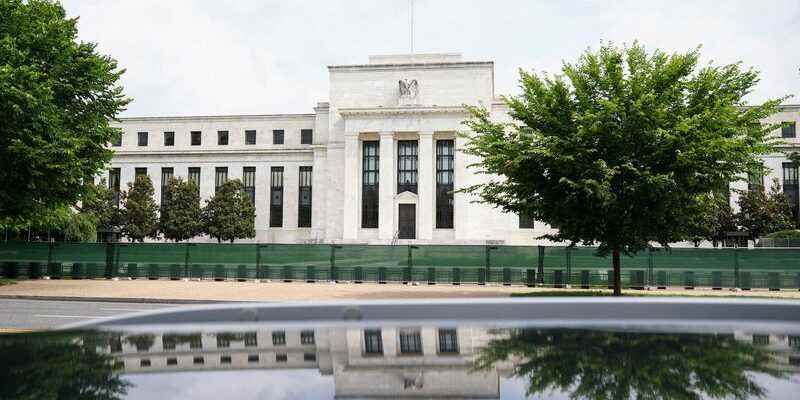Here’s a look at where policy makers stand in the race to contain runaway inflation.
Chart: Checklist for rate hikes Checklist for rate hikes –
1) NORWAY
Norway’s Norges Bank was the first major developed economy to launch a rate hike cycle last year and has raised rates three times since September. It is expected to increase its rate again by 0.75% on June 23 and plans seven other measures by the end of 2023.
Chart: Major central banks raise rates – https://fingfx.thomsonreuters.com/gfx/mkt/xmvjowkqjpr/rates1606.PNG
2) NEW ZLAND
The Reserve Bank of New Zealand is also one of the most hawkish central banks in the world. It raised the official bank rate by 50 basis points (bps) to 2% on May 25, a level not seen since 2016. It was its fifth consecutive rate hike.
It forecast rates to double to 4% over the coming year and stay there until 2024. during the year ending in the first quarter, against a target of 13%.
Chart :
The
New Zealand among the most aggressive central banks – https://fingfx.thomsonreuters.com/gfx/mkt/jnvwezdkqvw/NZ0706.PNG
3) CANADA
The Bank of Canada raised its interest rate for the second consecutive 50 basis points to 1.5% on June 1 and said it would “act more aggressively” if necessary.
With inflation at 6.8% in April, Governor Tiff Macklem did not rule out an increase of 75 basis points or more and said rates could be above the neutral 2%-3% range for some time.
BoC Deputy Governor Paul Beaudry has warned of “rampant” inflation and markets are pricing in an unprecedented third consecutive 50 basis point hike in July.
4) BRITTANY
The Bank of England raised interest rates by a quarter of a percentage point on Thursday and said it was ready to act “strongly” to remove the dangers posed by inflation topping 11%.
Britain’s benchmark rate is now at its highest level since January 2009. The BoE, the first major central bank to tighten monetary policy after the COVID-19 pandemic, has now raised borrowing costs five times since December.
Chart: Sterling –

5) UNITED STATES
On June 15, the Federal Reserve raised the target federal funds rate by three-quarters of a percentage point to bring it to a range between 1.5% and 1.75%.
The move was made days after an annual inflation rate of 8.6% was released and has since sparked a market frenzy, with expectations mounting for even more aggressive responses in the months ahead.
The Fed is also reducing its reserve of $9 trillion in assets accumulated during the pandemic.
Chart :
The balance sheets
central banks are starting to shrink — slowly – https://fingfx.thomsonreuters.com/gfx/mkt/akvezrwyzpr/balancesheets070622.PNG
6) AUSTRALIA
As the economy recovers smartly and inflation hits its highest level in 20 years (5.1%), the Reserve Bank of Australia raised its rates by a surprising 50 basis points on June 6th. It is the second consecutive move by the RBA after months of insisting that policy tightening was far from a reality.
Money markets are forecasting another 50 basis point rise in July.
7) SWEDEN
Coming late in the battle of inflation, the Swedish Riksbank raised its rates to 0.25% in April, by a quarter of a point. With inflation at 6.4%, compared to its target of 2%, the Riksbank could now opt for more significant measures.
After declaring as recently as February that rates would not be raised until 2024, the Riksbank plans to carry out two or three more hikes this year.
8) EUROZONE
Now firmly entrenched in the hawks’ camp and facing record inflation, the ECB said on June 9 that it would end its bond purchases on July 1, raise rates by 25 basis points that month for the first time since 2011 and that it would raise them again in September, probably ending the negative rates.
But without details on a tool to prevent the borrowing costs of southern European nations from diverging too much from those of Germany, the markets will test the resolve of the ECB.
The bank now plans to accelerate work on a potential new tool to contain fragmentation and direct proceeds from lucky bonds to troubled markets.
Chart :
L
eurozone inflation spikes – https://fingfx.thomsonreuters.com/gfx/mkt/egpbkwxeovq/ecb0706.PNG
9) SWITZERLAND
On June 16, the Swiss National Bank unexpectedly raised its interest rate by 50 basis points to -0.75%, the lowest in the world, thus causing the franc to explode.
The franc’s recent weakness has helped push inflation to 14-year highs and SNB Governor Thomas Jordan has said he no longer sees the franc as highly valued. This opened the door to betting on further rate hikes; a 100 basis point move is now expected for September.
10) JAPAN
Only the Bank of Japan remains as an undying dove.
BOJ chief Haruhiko Kuroda says the top priority is to support the economy, stressing his unwavering commitment to maintaining a “powerful” monetary stimulus.
In April, core consumer prices in Japan rose 2.1% from a year earlier, beating the BOJ’s target for the first time in seven years. However, BOJ officials consider such cost inflation to be temporary and there is no indication that it will signal a hawkish pivot at its June 17 meeting.
Chart: BOJ and JP CPI – https://fingfx.thomsonreuters.com/gfx/mkt/dwvkrnbyjpm/BOJ%20and%20JP%20CPI.JPG
